Build a Fraud Dispute Resolution Workflow with Orkes Conductor
In this tutorial, you’ll build a fraud dispute resolution workflow using Orkes Conductor. This workflow combines automated validation, AI-based risk scoring, and human review to determine whether a reported fraud case should be approved or rejected.
The workflow mimics real-world fraud handling processes in financial institutions, where initial validation and risk scoring are automated, and every dispute undergoes a human review for verification and final decision-making.
The fraud dispute workflow
In this tutorial, you’ll build a workflow where:
- A customer submits a fraud dispute request, including transaction details and supporting documentation.
- The system validates the input for correctness.
- An AI model analyzes the case details and classifies them into low, medium, or high risk.
- Based on the classification:
- Low and medium-risk disputes are referred to human reviewers for a decision.
- High-risk cases are routed to fraud investigators.
- Each case resolution triggers an email notification to the customer.
Here’s how the workflow looks like:
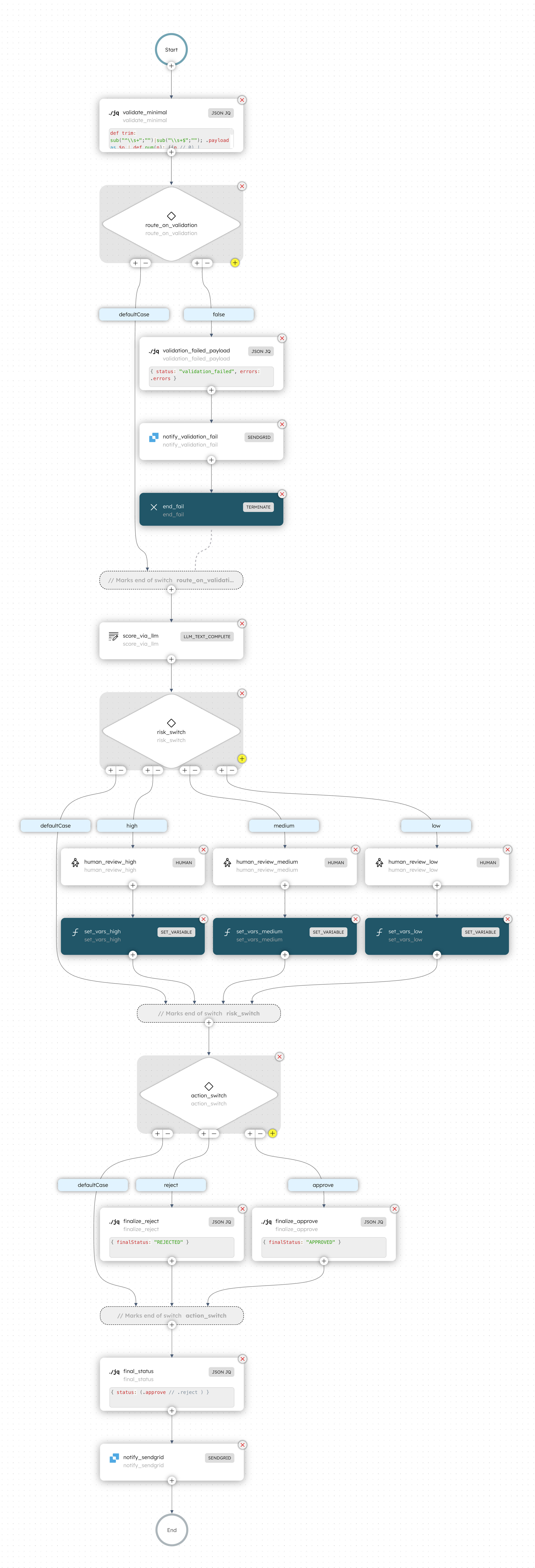
Follow along using the free Orkes Developer Edition. If you don’t have an account yet, sign up to get started.
Step 1: Create an OpenAI integration in Orkes Conductor
This workflow uses OpenAI to analyze dispute data and generate a risk classification (low, medium, or high).
To create an OpenAI integration:
- Go to Integrations from the left navigation menu on your Conductor cluster.
- Select + New integration.
- In the AI/LLM section, choose OpenAI.
- Select + Add and enter a name for the integration, API key, and a description.
- Select Save.
Step 2: Create a SendGrid integration in Orkes Conductor
In this tutorial, we’ll use SendGrid to send emails. To do that, you must set up a SendGrid integration in your Orkes Conductor cluster.
To create a SendGrid integration:
- Go to Integrations from the left navigation menu on your Conductor cluster.
- Select + New integration.
- In the Integrations section, choose SendGrid Email.
- Select + Add and enter a name for the integration, API key, and a description.
- Select Save.
Step 3: Create a user form in Orkes Conductor
The workflow uses a Human task in Orkes Conductor for manual review. Reviewers can complete approvals either through the Conductor UI or an external interface, such as an internal investigation portal.
In this tutorial, you’ll use the Conductor UI to complete approvals. For this, a user form is to be created in Conductor. To support this, you’ll create three separate user forms, one each for low, medium, and high risk disputes.
To create a user form:
- Go to Definitions > User Forms from the left navigation menu on your Conductor cluster.
- Select + New form.
- In the Code tab, paste the following code:
View code
{
"name": "FraudDisputeReviewHigh",
"version": 1,
"jsonSchema": {
"$schema": "http://json-schema.org/draft-07/schema",
"properties": {
"transactionId": {
"type": "string"
},
"amount": {
"type": "number"
},
"currency": {
"type": "string"
},
"reportedAt": {
"type": "string"
},
"reason": {
"type": "string"
},
"customerEmail": {
"type": "string"
},
"riskSummary": {
"type": "string"
},
"notes": {
"type": "string"
},
"reviewDecision": {
"type": "string",
"enum": [
"approve",
"reject"
]
}
},
"required": [
"notes",
"reviewDecision"
]
},
"templateUI": {
"type": "VerticalLayout",
"elements": [
{
"type": "Group",
"elements": [
{
"type": "Control",
"scope": "#/properties/transactionId",
"label": "Transaction ID",
"options": {
"readonly": true
}
},
{
"type": "Control",
"scope": "#/properties/amount",
"label": "Amount",
"options": {
"readonly": true
}
},
{
"type": "Control",
"scope": "#/properties/currency",
"label": "Currency",
"options": {
"readonly": true
}
},
{
"type": "Control",
"scope": "#/properties/reportedAt",
"label": "Reported At",
"options": {
"readonly": true
}
},
{
"type": "Control",
"scope": "#/properties/reason",
"label": "Customer Reason",
"options": {
"readonly": true,
"multi": true
}
},
{
"type": "Control",
"scope": "#/properties/customerEmail",
"label": "Customer Email",
"options": {
"readonly": true
}
},
{
"type": "Control",
"scope": "#/properties/riskSummary",
"label": "Risk (Label & Score)",
"options": {
"readonly": true
}
}
]
},
{
"type": "Group",
"elements": [
{
"type": "Control",
"scope": "#/properties/notes",
"label": "Investigation Summary",
"options": {
"multi": true
}
},
{
"type": "Control",
"scope": "#/properties/reviewDecision",
"label": "Final Decision",
"options": {}
}
]
}
]
}
}
- Select Save > Confirm.
Your user form looks like this:
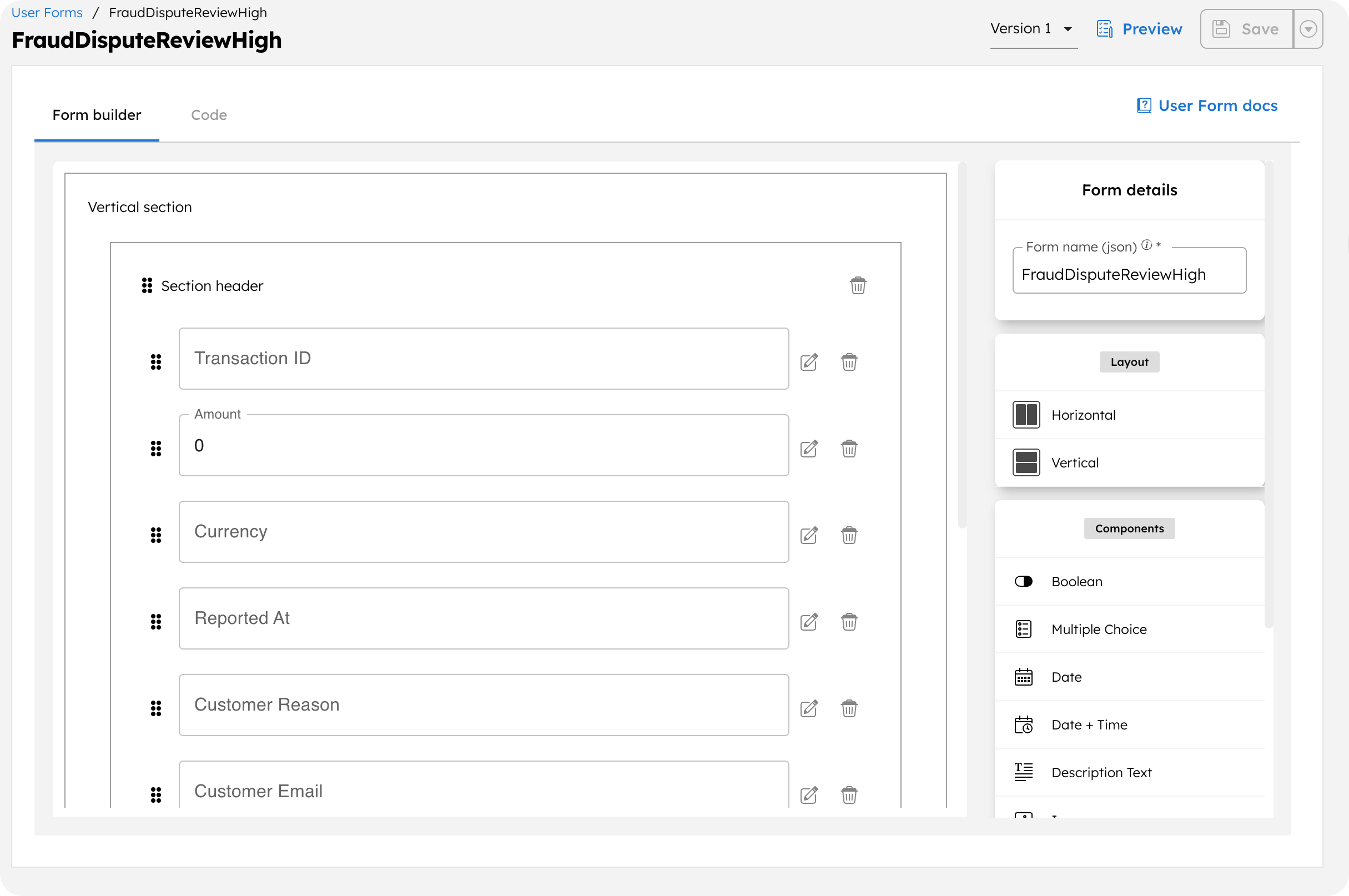
Next, repeat the same steps to create two additional user forms for medium and low risk disputes using the following code:
View code for FraudDisputeReviewMedium
{
"name": "FraudDisputeReviewMedium",
"version": 1,
"jsonSchema": {
"$schema": "http://json-schema.org/draft-07/schema",
"properties": {
"transactionId": {
"type": "string"
},
"amount": {
"type": "number"
},
"currency": {
"type": "string"
},
"reportedAt": {
"type": "string"
},
"reason": {
"type": "string"
},
"customerEmail": {
"type": "string"
},
"riskSummary": {
"type": "string"
},
"reviewDecision": {
"type": "string",
"enum": [
"approve",
"reject"
]
},
"notes": {
"type": "string"
}
},
"required": [
"reviewDecision"
]
},
"templateUI": {
"type": "VerticalLayout",
"elements": [
{
"type": "Group",
"elements": [
{
"type": "Control",
"scope": "#/properties/transactionId",
"label": "Transaction ID",
"options": {
"readonly": true
}
},
{
"type": "Control",
"scope": "#/properties/amount",
"label": "Amount",
"options": {
"readonly": true
}
},
{
"type": "Control",
"scope": "#/properties/currency",
"label": "Currency",
"options": {
"readonly": true
}
},
{
"type": "Control",
"scope": "#/properties/reportedAt",
"label": "Reported At",
"options": {
"readonly": true
}
},
{
"type": "Control",
"scope": "#/properties/reason",
"label": "Customer Reason",
"options": {
"readonly": true,
"multi": true
}
},
{
"type": "Control",
"scope": "#/properties/customerEmail",
"label": "Customer Email",
"options": {
"readonly": true
}
},
{
"type": "Control",
"scope": "#/properties/riskSummary",
"label": "Risk (Label & Score)",
"options": {
"readonly": true
}
}
]
},
{
"type": "Group",
"elements": [
{
"type": "Control",
"scope": "#/properties/reviewDecision",
"label": "Decision",
"options": {}
},
{
"type": "Control",
"scope": "#/properties/notes",
"label": "Notes (optional)",
"options": {
"multi": true
}
}
]
}
]
}
}
View code for FraudDisputeReviewLow
{
"name": "FraudDisputeReviewLow",
"version": 1,
"jsonSchema": {
"$schema": "http://json-schema.org/draft-07/schema",
"properties": {
"transactionId": {
"type": "string"
},
"amount": {
"type": "number"
},
"currency": {
"type": "string"
},
"reportedAt": {
"type": "string"
},
"reason": {
"type": "string"
},
"customerEmail": {
"type": "string"
},
"riskSummary": {
"type": "string"
},
"reviewDecision": {
"type": "string",
"enum": [
"approve",
"reject"
]
},
"notes": {
"type": "string"
}
},
"required": [
"reviewDecision"
]
},
"templateUI": {
"type": "VerticalLayout",
"elements": [
{
"type": "Group",
"elements": [
{
"type": "Control",
"scope": "#/properties/transactionId",
"label": "Transaction ID",
"options": {
"readonly": true
}
},
{
"type": "Control",
"scope": "#/properties/amount",
"label": "Amount",
"options": {
"readonly": true
}
},
{
"type": "Control",
"scope": "#/properties/currency",
"label": "Currency",
"options": {
"readonly": true
}
},
{
"type": "Control",
"scope": "#/properties/reportedAt",
"label": "Reported At",
"options": {
"readonly": true
}
},
{
"type": "Control",
"scope": "#/properties/reason",
"label": "Customer Reason",
"options": {
"readonly": true,
"multi": true
}
},
{
"type": "Control",
"scope": "#/properties/customerEmail",
"label": "Customer Email",
"options": {
"readonly": true
}
},
{
"type": "Control",
"scope": "#/properties/riskSummary",
"label": "Risk (Label & Score)",
"options": {
"readonly": true
}
}
]
},
{
"type": "Group",
"elements": [
{
"type": "Control",
"scope": "#/properties/reviewDecision",
"label": "Decision",
"options": {}
},
{
"type": "Control",
"scope": "#/properties/notes",
"label": "Notes (optional)",
"options": {
"multi": true
}
}
]
}
]
}
}
Step 4: Create an AI prompt in Orkes Conductor
The workflow uses an LLM Text Complete task in Orkes Conductor to classify the fraud dispute risk level using OpenAI. The task uses an AI prompt to facilitate this.
To create an AI prompt:
- Go to Definitions > AI Prompts from the left navigation menu on your Conductor cluster.
- Select + Add AI prompt.
- In the Code tab, paste the following code:
{
"name": "fraud_scoring_prompt",
"template": "You are a fraud risk analyst at a bank. Your job is to assess how likely the following customer dispute is genuine fraud vs. a misunderstanding.\n\nCONTEXT (runtime values):\n- Transaction ID: ${transactionId}\n- Amount: ${amount} ${currency}\n- Reported At: ${reportedAt}\n- Customer Reason: ${reason}\n\nINSTRUCTIONS:\n1) Use ONLY the context above. Do not invent facts. If a field is missing, treat it as null.\n2) Score fraud likelihood on a 0–100 scale.\n - Base thresholds:\n • low : score < 50\n • medium : 50–79\n • high : ≥ 80\n3) Heuristics (apply additively, but keep score in [0,100]):\n - Strong indicators → push higher: terms like “unauthorized”, “unknown”, “card not present/card-not-present/CNP”, “skimming”, “phished”, “hacked”, reported within 48h, unusually large amount.\n - Benign indicators → push lower: duplicate charge, service/quality issue, very small amount (< 20), very old (reported > 90 days later), vague/short reason (< 20 chars).\n4) Rationale must cite SPECIFIC evidence from the context (e.g., keywords, timing, amount). Keep it to one short sentence.\n5) OUTPUT MUST BE STRICT JSON. No prose before or after. Numbers must be numbers (not strings). No trailing commas.\n\nOUTPUT FORMAT (exact keys, exact order):\n{\n \"score\": <number 0-100>,\n \"label\": \"low|medium|high\",\n \"rationale\": \"<one short sentence citing evidence>\"\n}\n\nNOW PRODUCE ONLY THE JSON OBJECT.",
"description": "Generates a fraud risk assessment (score, label, rationale) based on transaction details and customer-provided reason for dispute.\n",
"variables": [
"reportedAt",
"reason",
"amount",
"currency",
"transactionId"
],
"integrations": [
"<YOUR-AI-PROVIDER>:<YOUR-LLM-MODEL>"
],
"tags": [],
"version": 1
}
- Select Save > Confirm Save.
Update the Model(s) drop-down with the OpenAI integration created in Step 1, and save the changes.
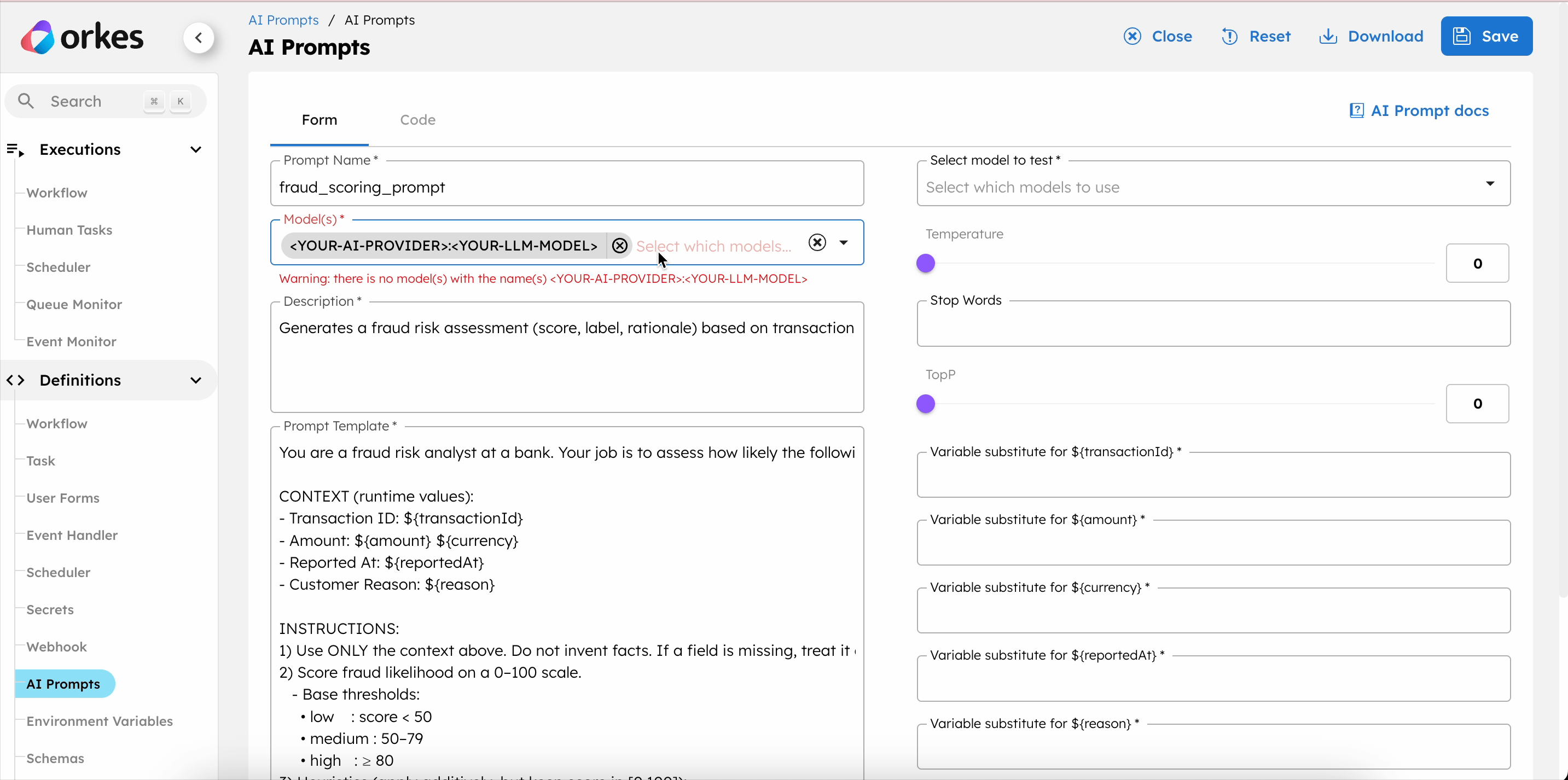
Step 5: Create a workflow in Orkes Conductor
Orkes Conductor lets you define workflows as JSON, through SDKs, APIs, or the UI.
To create a workflow using Conductor UI:
- Go to Definitions > Workflow from the left navigation menu on your Conductor cluster.
- Select + Define workflow.
- In the Code tab, paste the following code:
View code
{
"name": "fraud_dispute",
"description": "Semi-automated fraud dispute flow with LLM scoring and risk-tier human review plus SendGrid notification.",
"version": 1,
"tasks": [
{
"name": "validate_minimal",
"taskReferenceName": "validate_minimal",
"inputParameters": {
"payload": "${workflow.input}",
"queryExpression": "def trim: sub(\"^\\\\s+\";\"\")|sub(\"\\\\s+$\";\"\"); .payload as $p | def num(n): ((n // 0) | tonumber); { ok: ((($p.transactionId // \"\" | tostring | length) > 0) and (num($p.amount) > 0) and (($p.reason // \"\" | tostring | trim | length) >= 10) and (($p.customerEmail // \"\" | tostring | trim | length) > 3)), errors: [ if (($p.transactionId // \"\" | tostring | length) == 0) then {code:\"MISSING\", field:\"transactionId\"} else empty end, if (num($p.amount) <= 0) then {code:\"INVALID\", field:\"amount\"} else empty end, if (($p.reason // \"\" | tostring | trim | length) < 10) then {code:\"TOO_SHORT\", field:\"reason\"} else empty end, if (($p.customerEmail // \"\" | tostring | trim | length) <= 3) then {code:\"MISSING\", field:\"customerEmail\"} else empty end ], validated: { customerId: ($p.customerId // null), transactionId: ($p.transactionId | tostring | trim), amount: (num($p.amount)), currency: (($p.currency // null) | if . == null then null else (tostring | ascii_upcase | trim) end), reportedAt: ($p.reportedAt // null), reason: (($p.reason // \"\") | tostring | trim), customerEmail: (($p.customerEmail // \"\") | tostring | trim) } }"
},
"type": "JSON_JQ_TRANSFORM"
},
{
"name": "route_on_validation",
"taskReferenceName": "route_on_validation",
"inputParameters": {
"switchCaseValue": "${validate_minimal.output.result.ok}"
},
"type": "SWITCH",
"decisionCases": {
"false": [
{
"name": "validation_failed_payload",
"taskReferenceName": "validation_failed_payload",
"inputParameters": {
"errors": "${validate_minimal.output.result.errors}",
"queryExpression": "{ status: \"validation_failed\", errors: .errors }"
},
"type": "JSON_JQ_TRANSFORM"
},
{
"name": "notify_validation_fail",
"taskReferenceName": "notify_validation_fail",
"inputParameters": {
"from": "<YOUR-SENDGRID-VERIFIED-SENDER-EMAIL>",
"to": "${workflow.input.customerEmail}",
"subject": "ABC Bank: Fraud Dispute Submission Incomplete",
"contentType": "text/plain",
"content": "Dear Customer,\n\nWe were unable to process your fraud dispute request because some required information appears to be missing or incomplete.\n\nPlease review your submission and ensure all details are provided before resubmitting your request. This will help us process your case as quickly as possible.\n\nBest regards,\nFraud Investigation Team",
"sendgridConfiguration": "<YOUR-SENDGRID-UNTEGRATION>"
},
"type": "SENDGRID"
},
{
"name": "end_fail",
"taskReferenceName": "end_fail",
"inputParameters": {
"terminationStatus": "COMPLETED",
"workflowOutput": {},
"terminationReason": "Validation failed."
},
"type": "TERMINATE"
}
]
},
"defaultCase": [],
"evaluatorType": "value-param",
"expression": "switchCaseValue"
},
{
"name": "score_via_llm",
"taskReferenceName": "score_via_llm",
"inputParameters": {
"llmProvider": "<YOUR-LLM-PRVIDER>",
"model": "<YOUR-LLM-MODEL>",
"promptName": "fraud_scoring_prompt",
"promptVariables": {
"amount": "${workflow.input.amount}",
"currency": "${workflow.input.currency}",
"reportedAt": "${workflow.input.reportedAt}",
"reason": "${workflow.input.reason}",
"transactionId": "${workflow.input.transactionId}"
},
"temperature": 0.2,
"maxTokens": "200"
},
"type": "LLM_TEXT_COMPLETE"
},
{
"name": "risk_switch",
"taskReferenceName": "risk_switch",
"inputParameters": {
"switchCaseValue": "${score_via_llm.output.result.label}"
},
"type": "SWITCH",
"decisionCases": {
"low": [
{
"name": "human_review_low",
"taskReferenceName": "human_review_low",
"inputParameters": {
"__humanTaskDefinition": {
"displayName": "Low risk - Fraud dispute",
"userFormTemplate": {
"name": "FraudDisputeReviewLow",
"version": 1
}
},
"transactionId": "${workflow.input.transactionId}",
"amount": "${workflow.input.amount}",
"currency": "${workflow.input.currency}",
"reportedAt": "${workflow.input.reportedAt}",
"reason": "${workflow.input.reason}",
"customerEmail": "${workflow.input.customerEmail}",
"riskSummary": "${score_via_llm.output.result.rationale}"
},
"type": "HUMAN"
},
{
"name": "set_vars_low",
"taskReferenceName": "set_vars_low",
"inputParameters": {
"reviewDecision": "${human_review_low.output.reviewDecision}",
"notes": "${human_review_low.output.notes}"
},
"type": "SET_VARIABLE"
}
],
"medium": [
{
"name": "human_review_medium",
"taskReferenceName": "human_review_medium",
"inputParameters": {
"__humanTaskDefinition": {
"displayName": "Medium risk - Fraud dispute",
"userFormTemplate": {
"name": "FraudDisputeReviewMedium",
"version": 1
}
},
"transactionId": "${workflow.input.transactionId}",
"amount": "${workflow.input.amount}",
"currency": "${workflow.input.currency}",
"reportedAt": "${workflow.input.reportedAt}",
"reason": "${workflow.input.reason}",
"customerEmail": "${workflow.input.customerEmail}",
"riskSummary": "${score_via_llm.output.result.rationale}"
},
"type": "HUMAN"
},
{
"name": "set_vars_medium",
"taskReferenceName": "set_vars_medium",
"inputParameters": {
"reviewDecision": "${human_review_medium.output.reviewDecision}",
"notes": "${human_review_medium.output.notes}"
},
"type": "SET_VARIABLE"
}
],
"high": [
{
"name": "human_review_high",
"taskReferenceName": "human_review_high",
"inputParameters": {
"__humanTaskDefinition": {
"displayName": "High risk - Fraud dispute",
"userFormTemplate": {
"name": "FraudDisputeReviewHigh",
"version": 1
}
},
"transactionId": "${workflow.input.transactionId}",
"amount": "${workflow.input.amount}",
"currency": "${workflow.input.currency}",
"reportedAt": "${workflow.input.reportedAt}",
"reason": "${workflow.input.reason}",
"customerEmail": "${workflow.input.customerEmail}",
"riskSummary": "${score_via_llm.output.result.rationale}"
},
"type": "HUMAN"
},
{
"name": "set_vars_high",
"taskReferenceName": "set_vars_high",
"inputParameters": {
"reviewDecision": "${human_review_high.output.reviewDecision}",
"notes": "${human_review_high.output.notes}"
},
"type": "SET_VARIABLE"
}
]
},
"defaultCase": [],
"evaluatorType": "value-param",
"expression": "switchCaseValue"
},
{
"name": "action_switch",
"taskReferenceName": "action_switch",
"inputParameters": {
"switchCaseValue": "${workflow.variables.reviewDecision}"
},
"type": "SWITCH",
"decisionCases": {
"approve": [
{
"name": "finalize_approve",
"taskReferenceName": "finalize_approve",
"inputParameters": {
"transactionId": "${workflow.input.transactionId}",
"queryExpression": "{ finalStatus: \"APPROVED\" }"
},
"type": "JSON_JQ_TRANSFORM"
}
],
"reject": [
{
"name": "finalize_reject",
"taskReferenceName": "finalize_reject",
"inputParameters": {
"queryExpression": "{ finalStatus: \"REJECTED\" }"
},
"type": "JSON_JQ_TRANSFORM"
}
]
},
"defaultCase": [],
"evaluatorType": "value-param",
"expression": "switchCaseValue"
},
{
"name": "final_status",
"taskReferenceName": "final_status",
"inputParameters": {
"approve": "${finalize_approve.output.result.finalStatus}",
"reject": "${finalize_reject.output.result.finalStatus}",
"queryExpression": "{ status: (.approve // .reject ) }"
},
"type": "JSON_JQ_TRANSFORM"
},
{
"name": "notify_sendgrid",
"taskReferenceName": "notify_sendgrid",
"inputParameters": {
"from": "<YOUR-SENDGRID-VERIFIER-SENDER-EMAIL>",
"to": "${workflow.input.customerEmail}",
"subject": "ABC Bank: Your fraud dispute update",
"contentType": "text/plain",
"content": "Dear Customer,\n\nWe’ve completed the review of your fraud dispute for Transaction ID: ${workflow.input.transactionId}.\n\nFinal Decision: ${final_status.output.result.status}\n\nThank you for your patience.\n\nBest regards,\nFraud Investigation Team",
"sendgridConfiguration": "<YOUR-SENDGRID-INTEGRATION>"
},
"type": "SENDGRID"
}
],
"inputParameters": [
"transactionId",
"amount",
"currency",
"reportedAt",
"reason",
"customerId",
"customerEmail"
],
"schemaVersion": 2
}
- Select Save > Confirm.
Next, replace all placeholder values with your actual data and integrations.
- Select the LLM Text Complete task, and update the LLM provider and Model with your configurations created in Step 1.
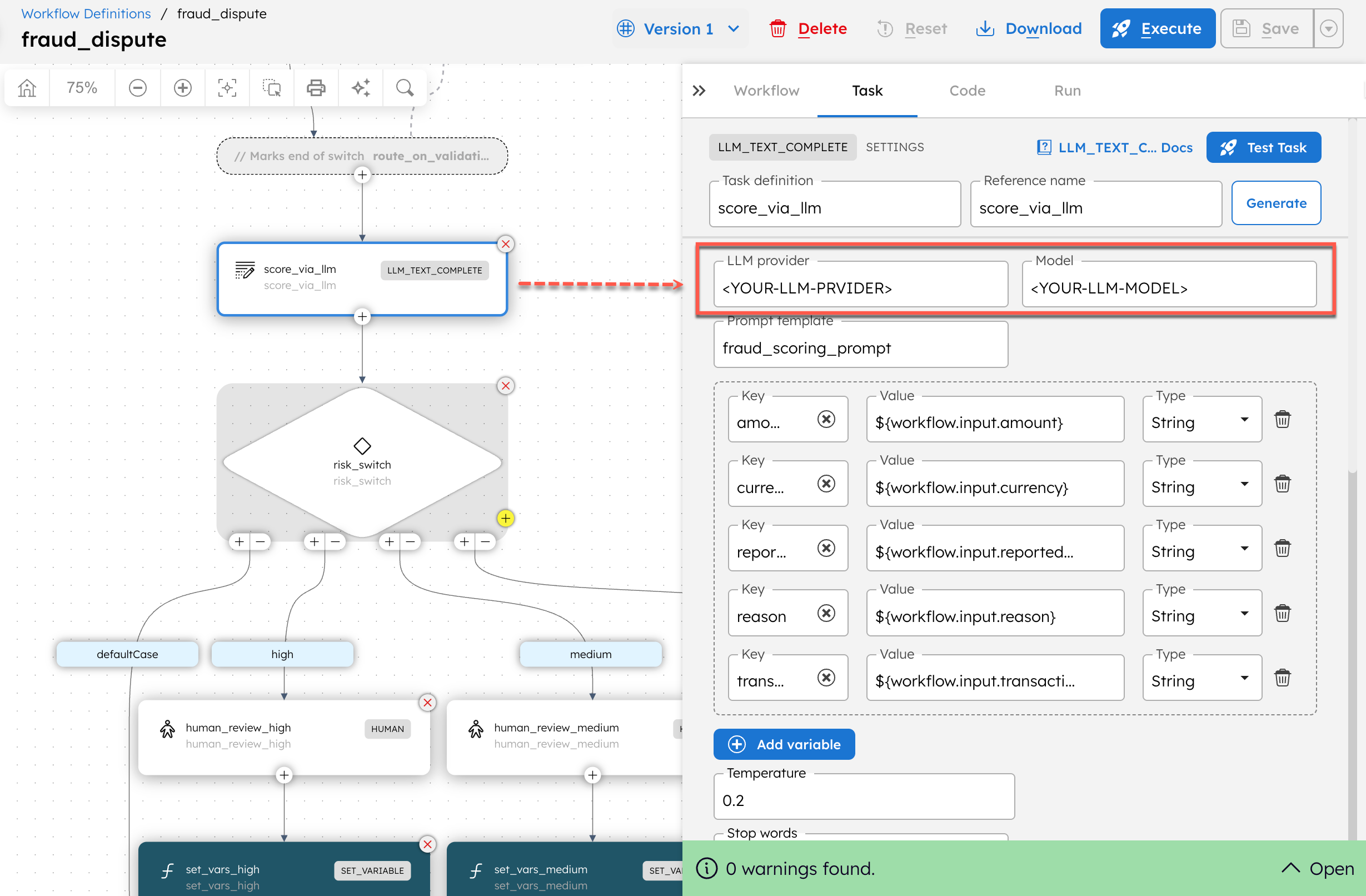
- Select the SendGrid (notify_validation_fail) task and update the following parameters:
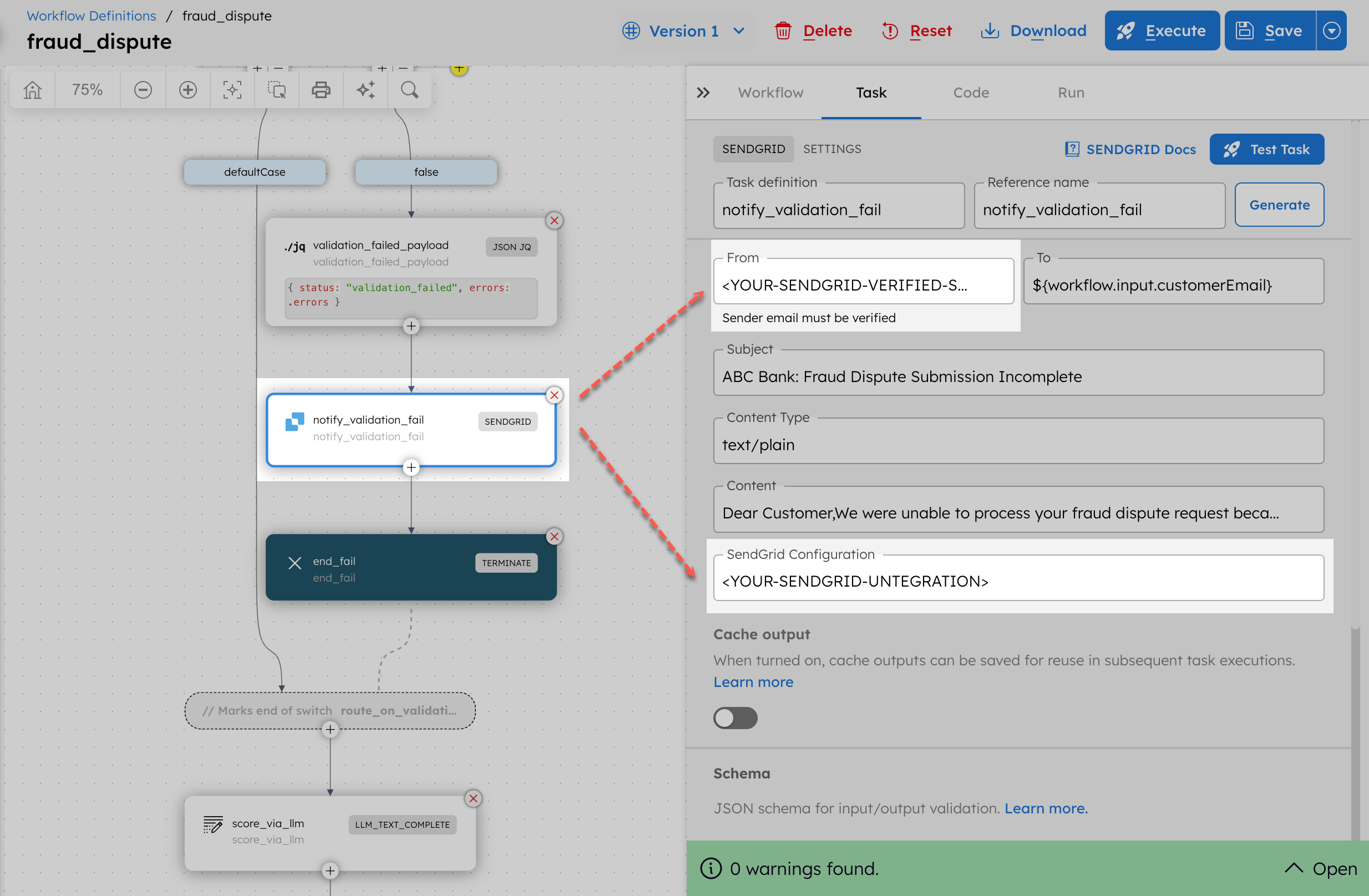
- Update the notify_sendgrid task with the same email and integration values.
- Select Save > Confirm.
Step 6: Execute workflow
To test the workflow:
- From your workflow definition, go to the Run tab.
- Set the input parameter. For example:
{
"transactionId": "",
"amount": 0,
"currency": "USD",
"reportedAt": "2025-11-06T10:00:00Z",
"reason": "short",
"customerEmail": "<YOUR-RECIPINET-EMAIL-FOR-TESTING>",
"customerId": "C1234"
}
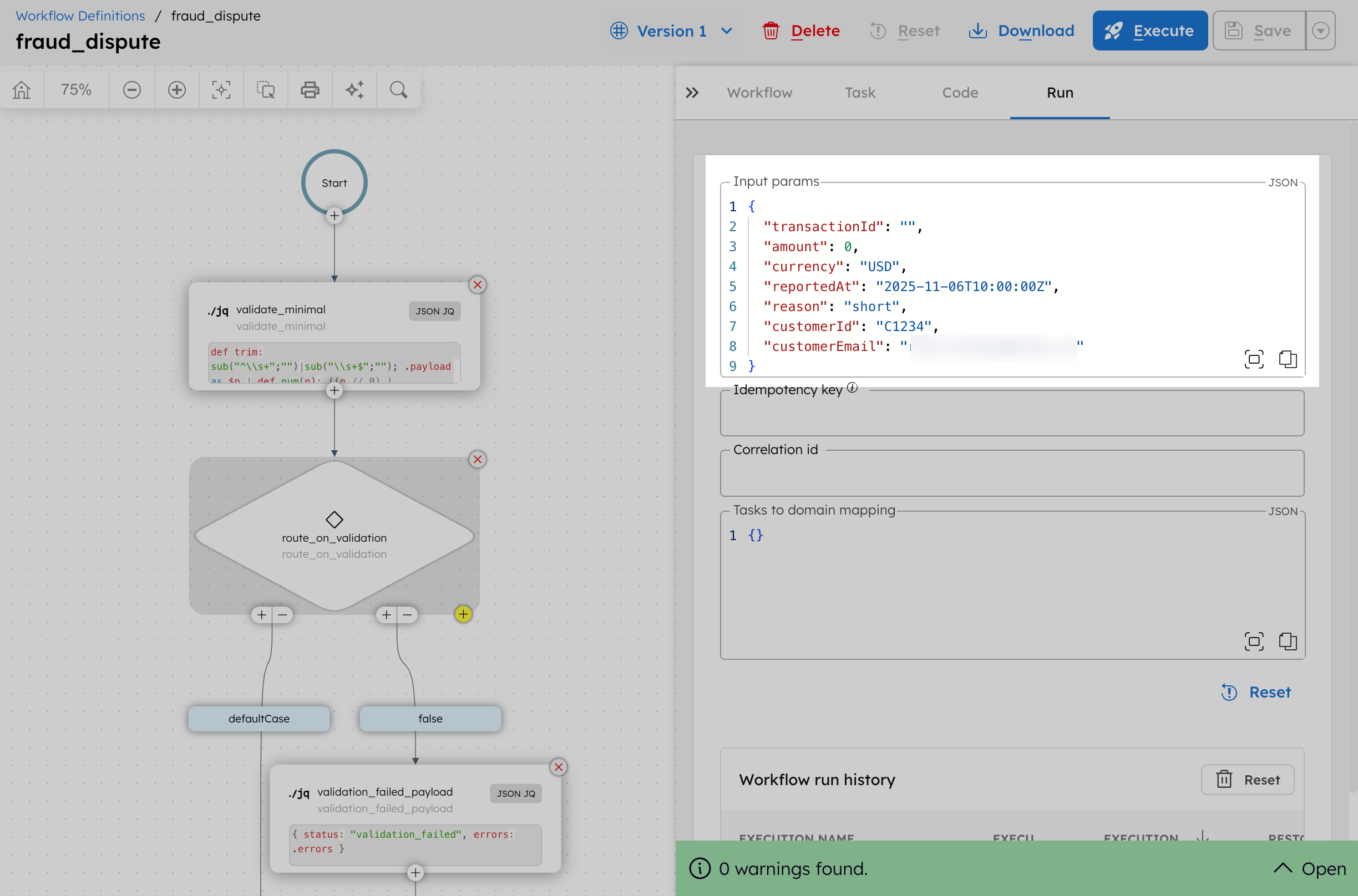
- Select Execute.
This initiates the workflow and takes you to the workflow execution page. Since the transaction ID and amount are invalid, the validation fails, causing the workflow to terminate and notifying the customer to resubmit with correct details.
In this example, validation is simulated using a JSON JQ Transform task for basic checks. In a production setup, you can replace this step with an API call to your internal payment or dispute validation system.
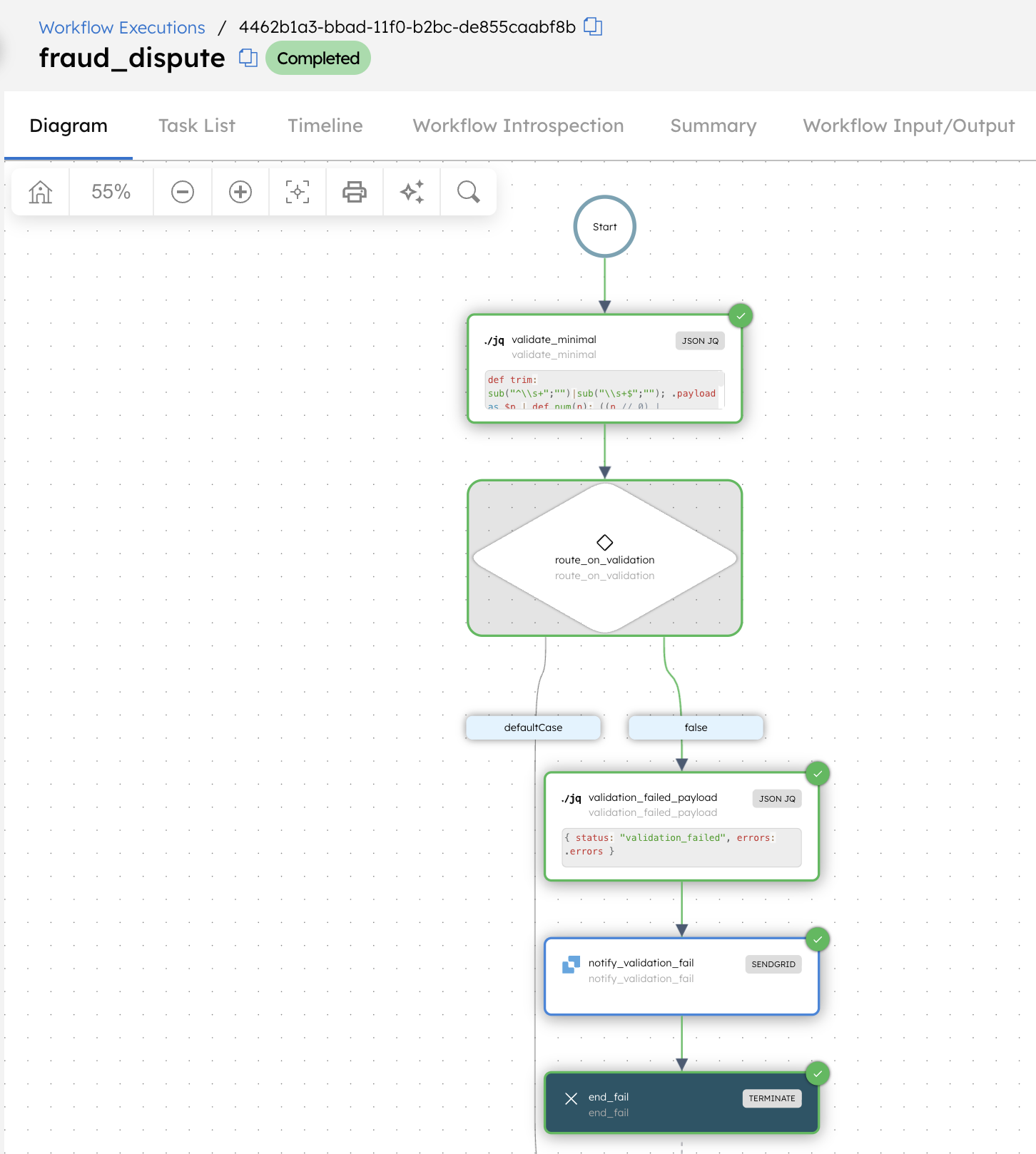
The user receives an email as follows:

Now, let’s rerun the workflow for a low-risk case. Here’s the updated workflow input:
{
"reportedAt": "2025-11-06T10:00:00Z",
"reason": "Customer reported a duplicate charge on card ending 4321",
"amount": 120.5,
"customerEmail": "<YOUR-RECIPINET-EMAIL-FOR-TESTING>",
"customerId": "CUST_0091",
"currency": "USD",
"transactionId": "TXN1001"
}
This initiates the workflow and takes you to the workflow execution page. The LLM classifies the dispute as low risk. The Conductor UI receives a human task, which anyone on the team can claim, review the case, and mark it as approved or rejected.
Completing the Human task
The workflow is running, and the Human task is available to claim.
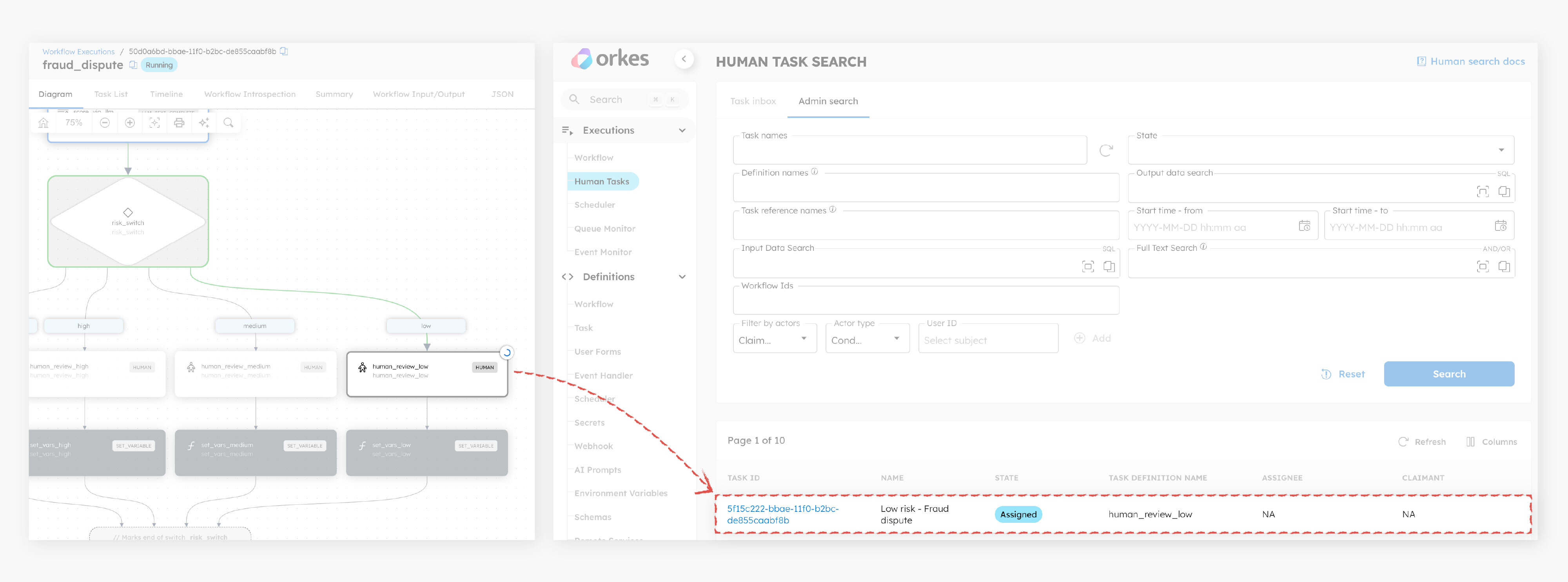
To complete the Human tasks in the UI:
- Go to Executions > Human Task.
- Select the Task ID to view the form.
- Select Claim.
- Review the dispute details, select the approval status, and leave comments.
- Select Complete to submit the form.
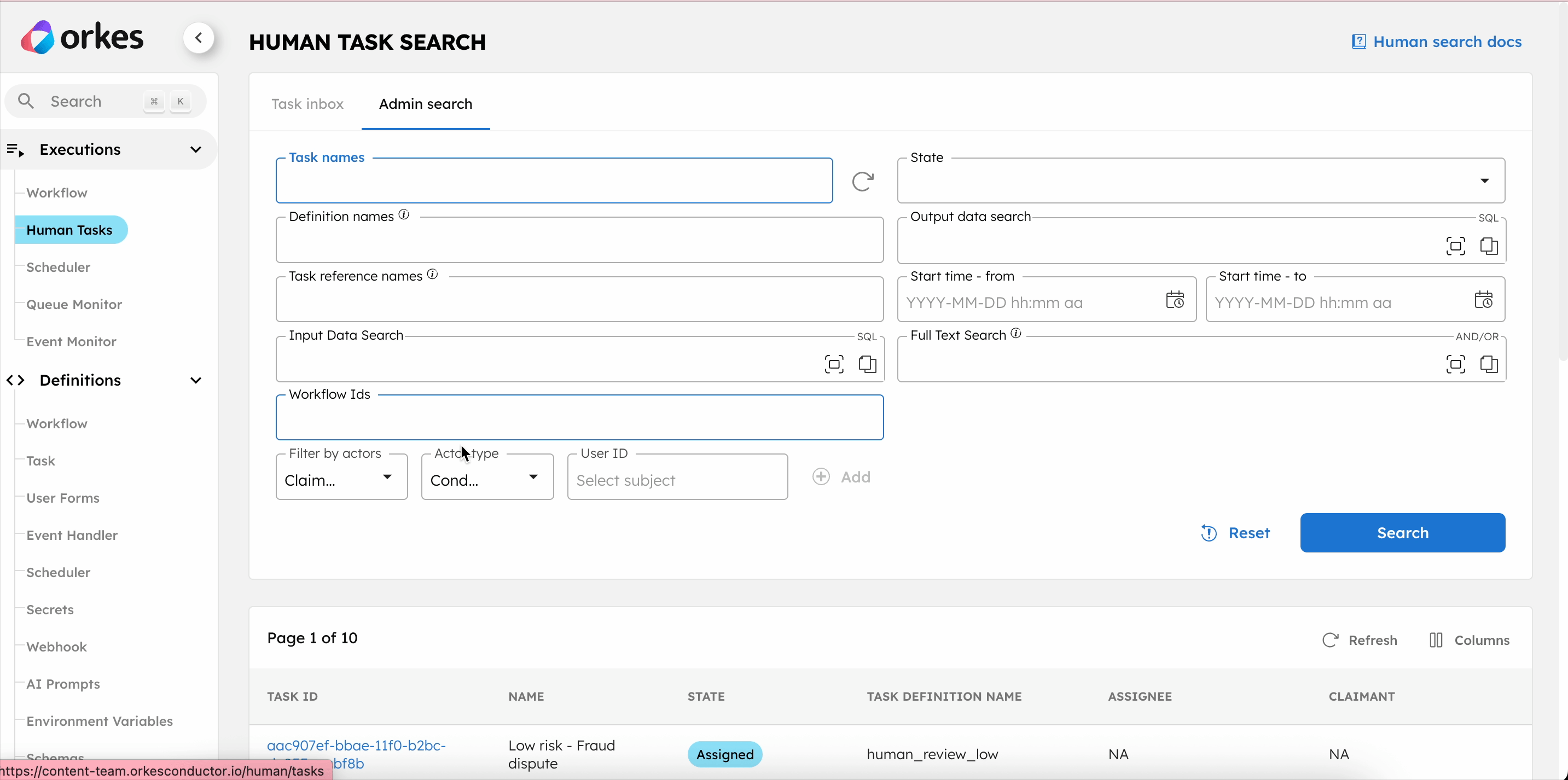
In this example, no assignment policy has been configured, so any user in the cluster can claim the task. In a production environment, each Human task (low, medium, and high) should be assigned to designated users or user groups. Learn more about configuring assignment policies for Human tasks in Orkes Conductor.
Once the reviewer approves the dispute, the workflow is completed, and the user receives an update email via SendGrid.
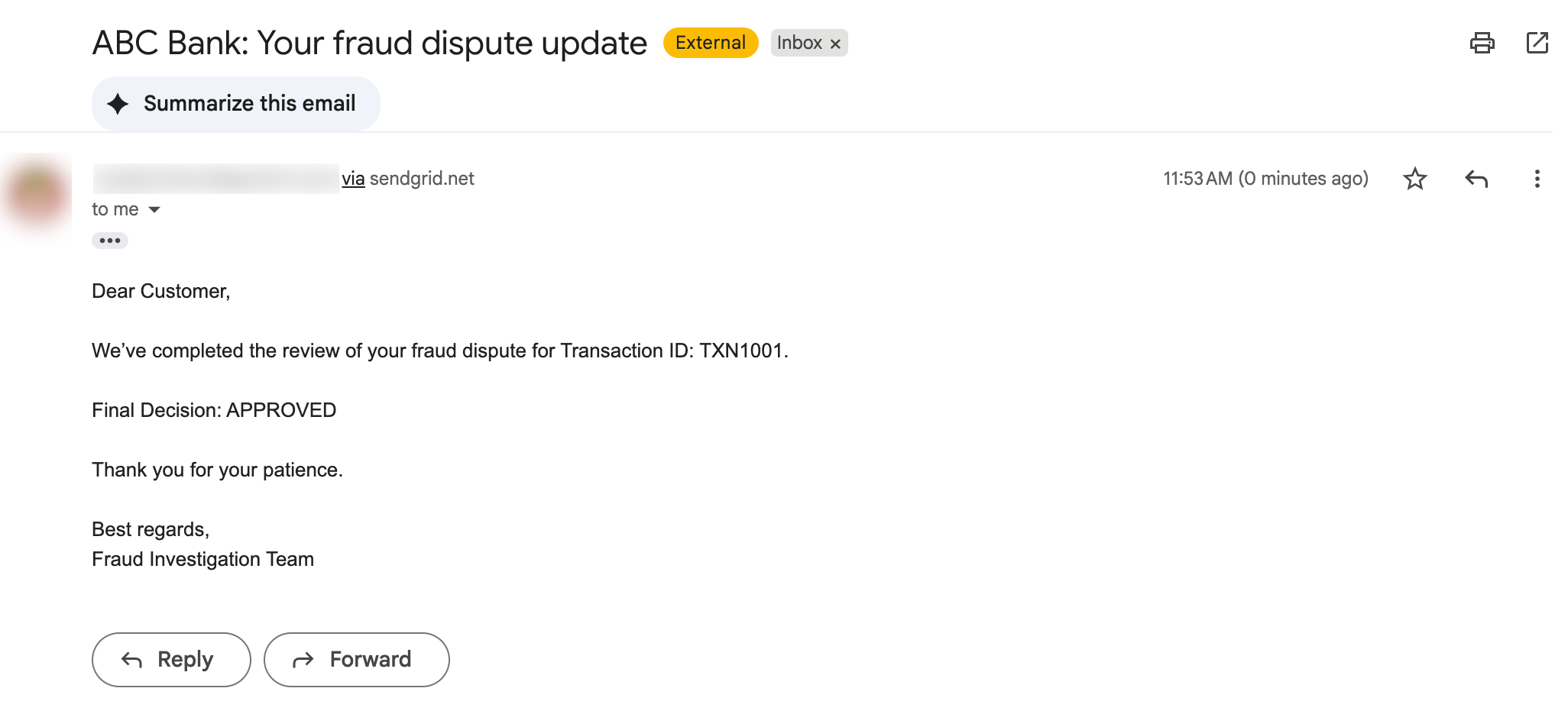
Workflow modifications
This fraud dispute workflow can be extended by:
- Adding new validation rules (e.g., suspicious location or IP checks).
- Adjusting the thresholds for low, medium, and high risk classification in the prompt.
- Customizing reviewer assignment policies for SLA management.
- Integrating third-party fraud detection APIs for deeper analysis.
- Customizing the email templates for escalation or partial refund cases.